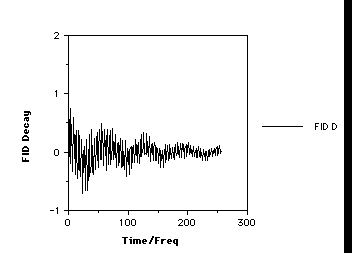
q = g. B1.tp (6)
A value of q
=90° is often referred to as a 90°
pulse because of the angle the magnetisation vector is changed by, ie from
the z axis into the xy plane!. In practice, values of q
~30° are often selected for practical reasons, although
even 180° pulses are sometimes used. Our particular
pulse stops after tp seconds, when all the various protons have an
excited state population which is no longer in equilibrium with the ground
state as defined by equation (5) (indeed as noted above, with a 180° pulse the equilibrium is inverted).
Equilibrium is
re-established via spin-lattice and spin-spin relaxation, a process
which takes about 5-6 seconds for protons (cf T1and T 2 above) and which involves the
return of the macroscopic vector M to the z axis, ie the "flip"
angle q decays back to zero (exponentially) in about 5-6 seconds for
typical protons. M for each set of different protons will have a
different Larmor precession frequency, which in this example will span the
range 600 Hz. As long as q is not 0, the resultant non-zero vector component
of M in the direction of the receiver coil placed on the y axis
induces a sinusoidal current in this receiver. Each set of distinct protons
will produce a sine (or cosine) wave whose frequency matches their precession
frequency and the intensity of which is related not only to the phase of the
sine wave but also to the value of q at any instant (ie the
magnitude of the y component of M). The signal detected in the
receiver therefore resembles a collection of exponentially decaying sine
waves, and is called a Free Induction Decay, or FID for short;
